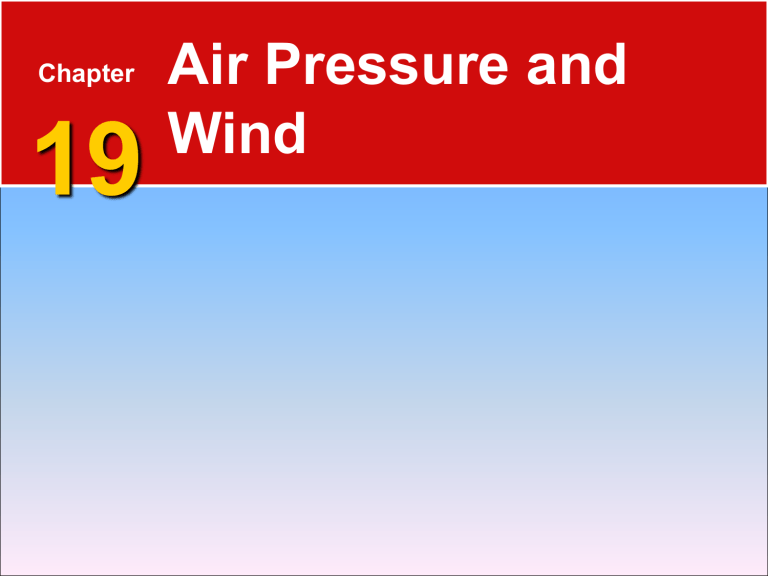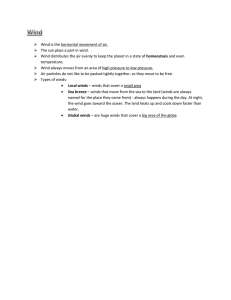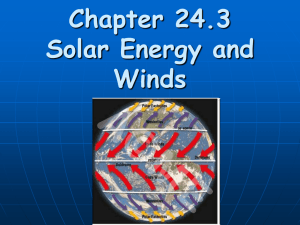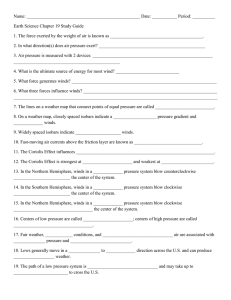Factors Affecting Wind 19.1 Understanding Air Pressure

Chapter
19
Air Pressure and
Wind
19.1 Understanding Air Pressure
Air Pressure Defined
Air pressure is the pressure exerted by the weight of air.
19.1 Understanding Air Pressure
Air Pressure Defined
Air pressure is the pressure exerted by the weight of air.
Air pressure is exerted in all directions — down, up, and sideways. The air pressure pushing down on an object exactly balances the air pressure pushing up on the object.
19.1 Understanding Air Pressure
Measuring Air Pressure
A barometer is a device used for measuring air pressure.
19.1 Understanding Air Pressure
Measuring Air Pressure
When air pressure increases, the mercury in the tube rises. When air pressure decreases, so does the height of the mercury column.
A Mercury Barometer
19.1 Understanding Air Pressure
Factors Affecting Wind
Wind is the result of horizontal differences in air pressure. Air flows from areas of higher pressure to areas of lower pressure.
19.1 Understanding Air Pressure
Factors Affecting Wind
The unequal heating of Earth’s surface generates pressure differences. Solar radiation is the ultimate energy source for most wind.
19.1 Understanding Air Pressure
Factors Affecting Wind
Three factors combine to control wind: pressure differences, the Coriolis effect, and friction.
19.1
Understanding Air Pressure
Factors Affecting Wind
Pressure Differences
• A pressure gradient is the amount of pressure change occurring over a given distance.
19.1
Understanding Air Pressure
Factors Affecting Wind
Pressure Differences
• Closely spaced isobars—lines on a map that connect places of equal air pressure —indicate a steep pressure gradient and high winds. Widely spaced isobars indicate a weak pressure gradient and light winds.
Isobars
19.1
Understanding Air Pressure
Factors Affecting Wind
Coriolis Effect
• The Coriolis effect describes how Earth’s rotation affects moving objects. In the Northern
Hemisphere, all free-moving objects or fluids, including the wind, are deflected to the right of their path of motion. In the Southern
Hemisphere, they are deflected to the left.
The Coriolis Effect
19.1
Understanding Air Pressure
Factors Affecting Wind
Friction
• Friction acts to slow air movement, which changes wind direction.
19.1
Understanding Air Pressure
Factors Affecting Wind
Friction
• Jet streams are fast-moving rivers of air that travel between 120 and 240 kilometers per hour in a west-to-east direction.
Effect of Friction
19.2 Pressure Centers and Winds
Highs and Lows
Cyclones are centers of low pressure.
Anticyclones are centers of high pressure.
19.2 Pressure Centers and Winds
Highs and Lows
In cyclones, the pressure decreases from the outer isobars toward the center. In anticyclones, just the opposite is the case — the values of the isobars increase from the outside toward the center.
19.2 Pressure Centers and Winds
Highs and Lows
Cyclonic and Anticyclonic Winds
• When the pressure gradient and the Coriolis effect are applied to pressure centers in the
Northern Hemisphere, winds blow counterclockwise around a low. Around a high, they blow clockwise.
19.2 Pressure Centers and Winds
Highs and Lows
Cyclonic and Anticyclonic Winds
• In either hemisphere, friction causes a net flow of air inward around a cyclone and a net flow of air outward around an anticyclone.
Cyclonic and Anticyclonic Winds
19.2 Pressure Centers and Winds
Highs and Lows
Weather and Air Pressure
• Rising air is associated with cloud formation and precipitation, whereas sinking air produces clear skies.
19.2 Pressure Centers and Winds
Highs and Lows
Weather Forecasting
• Weather reports emphasize the locations and possible paths of cyclones and anticyclones.
• Low-pressure centers can produce bad weather in any season.
Airflow Patterns, Surface and Aloft
19.2
Pressure Centers and Winds
Global Winds
The atmosphere balances these differences by acting as a giant heat-transfer system.
This system moves warm air toward high latitudes and cool air toward the equator.
19.2
Pressure Centers and Winds
Global Winds
Non-Rotating Earth Model
• On a hypothetical non-rotating planet with a smooth surface of either all land or all water, two large thermally produced cells would form.
Circulation on a Non-Rotating Earth
19.2 Pressure Centers and Winds
Global Winds
Rotating Earth Model
• If the effect of rotation were added to the global circulation model, the two-cell convection system would break down into smaller cells.
19.2 Pressure Centers and Winds
Global Winds
Rotating Earth Model
• Trade winds are two belts of winds that blow almost constantly from easterly directions and are located on the north and south sides of the subtropical highs.
19.2 Pressure Centers and Winds
Global Winds
Rotating Earth Model
• Westerlies are the dominant west-to-east motion of the atmosphere that characterizes the regions on the poleward side of the subtropical highs.
19.2 Pressure Centers and Winds
Global Winds
Rotating Earth Model
• Polar easterlies are winds that blow from the polar high toward the subpolar low. These winds are not constant like the trade winds.
19.2 Pressure Centers and Winds
Global Winds
Rotating Earth Model
• A polar front is a stormy frontal zone separating cold air masses of polar origin from warm air masses of tropical origin.
Circulation on a Rotating Earth
19.2 Pressure Centers and Winds
Global Winds
Influence of Continents
• The only truly continuous pressure belt is the subpolar low in the Southern Hemisphere. In the
Northern Hemisphere, where land masses break up the ocean surface, large seasonal temperature differences disrupt the pressure pattern.
19.2 Pressure Centers and Winds
Global Winds
Influence of Continents
• Monsoons are the seasonal reversal of wind direction associated with large continents, especially Asia. In winter, the wind blows from land to sea. In summer, the wind blows from sea to land.
Surface Pressure
19.3
Regional Wind Systems
Local Winds
The local winds are caused either by topographic effects or by variations in surface composition —land and water—in the immediate area.
19.3
Regional Wind Systems
Local Winds
Land and Sea Breezes
• In coastal areas during the warm summer months, the land surface is heated more intensely during the daylight hours than an adjacent body of water is heated. As a result, the air above the land surface heats, expands, and rises, creating an area of lower pressure. At night the reverse takes place.
Sea and Land Breezes
19.3
Regional Wind Systems
Local Winds
Valley and Mountain Breezes
• In mountainous regions during daylight hours, the air along the slopes of the mountains is heated more intensely than the air at the same elevation over the valley floor. Because this warmer air on the mountain slopes is less dense, it glides up along the slope and generates a valley breeze. After sunset the pattern may reverse.
Valley and Mountain Breezes
19.3
Regional Wind Systems
How Wind Is Measured
Wind Direction
• The prevailing wind is the wind that blows more often from one direction than from any other.
19.3
Regional Wind Systems
How Wind Is Measured
Wind Direction
• In the United States, the westerlies consistently move weather from west to east across the continent.
19.3
Regional Wind Systems
How Wind Is Measured
Wind Speed
• An anemometer is an instrument that resembles a cup and is commonly used to measure wind speed.
19.3
Regional Wind Systems
El Ni ñ o and La Ni ñ a
El Ni ño
• El Ni ñ o is the name given to the periodic warming of the ocean that occurs in the central and eastern Pacific.
19.3
Regional Wind Systems
El Ni ñ o and La Ni ñ a
El Ni ño
• At irregular intervals of three to seven years, these warm countercurrents become unusually strong and replace normally cold offshore waters with warm equatorial waters.
19.3
Regional Wind Systems
El Ni ñ o and La Ni ñ a
El Ni ño
• A major El Ni ñ o episode can cause extreme weather in many parts of the world.
Normal Conditions
El Niño Conditions
19.3
Regional Wind Systems
El Ni ñ o and La Ni ñ a
La Ni ñ a
• Researchers have come to recognize that when surface temperatures in the eastern Pacific are colder than average, a La Ni ñ a event is triggered that has a distinctive set of weather patterns.
19.3
Regional Wind Systems
Global Distribution of Precipitation
Global precipitation can be explained if knowledge of global winds and pressure systems are applied.







